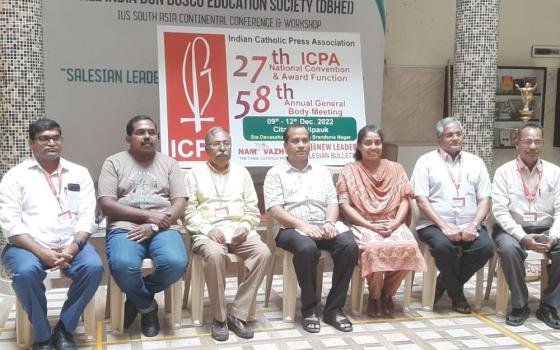By JOHN L. ALLEN JR.
New York
There’s a peculiar bit of subtext to media coverage of Pope Benedict XVI’s visit to the United States, one to which I may be particularly sensitive, given that I have spent a considerable portion of the last four days sitting on a television set somewhere listening to the segments that either precede or follow reports about the pope.
Simply put, the subtext is this: At least as a TV story, the pope is barely holding his own against the polygamists.
Naturally, that statement cries out for immediate nuance. The pope’s trip has drawn broad coverage in the American press, with extensive portions of many events carried live on television and recapped in detail on the front pages of national newspapers. Comment on the trip so far has been largely positive, with many media outlets giving particular emphasis to the forthright way the pope has engaged the sexual abuse crisis. The large and enthusiastic crowd at Nationals Stadium on Thursday impressed many analysts, as did the symbolic importance of the pope’s visit earlier today to the Park East Synagogue in Manhattan. Even Benedict’s brief meeting with the staff of the United Nations today drew notice, especially given the spontaneous affection the UN personnel demonstrated.
Taking the full scope of media coverage into view, Benedict clearly seems the week’s winner. A quick Nexis search for April 18 found 578 entries under “Benedict XVI” and just 178 under “polygamist.”
It’s hardly the case, therefore, that the American media are ignoring or downplaying the pope.
Yet for all that, I suspect that a content analysis of the American media this week – especially television, and especially in prime time – would reveal that the polygamists have been at least as big a phenomenon. I also suspect that on the street, the polygamists are scoring higher on the “buzz” meter than the pope.
Those are assumptions, not facts. If they’re correct, however, the truly interesting part is trying to figure out why the pope and the polygamists are running neck and neck for airtime.
It’s certainly not because the natural constituencies of the two stories are roughly equal. There are almost 70 million Catholics in the United States, representing one-quarter of the country’s population. Estimates for the following of the Fundamentalist Church of Jesus Christ of Latter Day Saints, the religious group at the center of the polygamist story, are roughly 6,000 to 10,000.
It’s also not because the news value of the two stories is commensurate. The pope is a towering global figure, and his trip opens up a far wider horizon of issues: relations among Christianity, Judaism and Islam; the fate of the “Catholic vote” in 2008; immigration and the changing face of Catholicism in America; the delicate balance between truth and tolerance in an increasingly pluralized word; and many more matters besides.
It’s not simply because the polygamist story involves allegations of sexual abuse of minors, a theme always guaranteed to draw an audience. Since Benedict XVI has made the sexual abuse crisis in the Catholic church a centerpiece of his message here, his trip too opens up the same territory.
Finally, I doubt it’s due to Benedict’s alleged “charisma deficit.” If anything, most commentary so far into the trip has focused on what a surprisingly warm and gracious figure Benedict seems, and how crowds seem to respond well even if he lacks the raw magnetism of John Paul II.
What then?
t
No doubt a variety of factors are at work. For one thing, images of the women living in the Texas compound who are unwilling to divulge the ages at which they married, or even their last names, and appearing to parrot a kind of “party line,” are undeniably riveting. For another, the massive on-going legal process in Texas regarding the disposition of the children involved provides a recurrent daily storyline.
I suspect a central element, however, is that while both stories involve the intersection between religion and sex, they’re at different points in their respective arcs.
The polygamist story is, in a sense, where the priestly sex abuse story was back in late 2001 and 2002, when it was drawing saturation coverage. In any scandal, healing inevitably follows exposure. While Benedict’s trip is largely about the healing part, the polygamist story is still in the exposure phase.
If that’s correct, competition between the two stories this week for which one leads in prime time confirms a simple truth: Exposure of wrongdoing is often more captivating than efforts to make it right. Without that fact of human psychology, it’s tough to explain why these two storylines are even in the same league.
As Dante found out with reaction to his Divine Comedy, sin is more interesting than redemption. It might be tempting to blame that on the media, but it might also be worth asking if the fault, if that’s the right word, is less in our stars than in ourselves.




